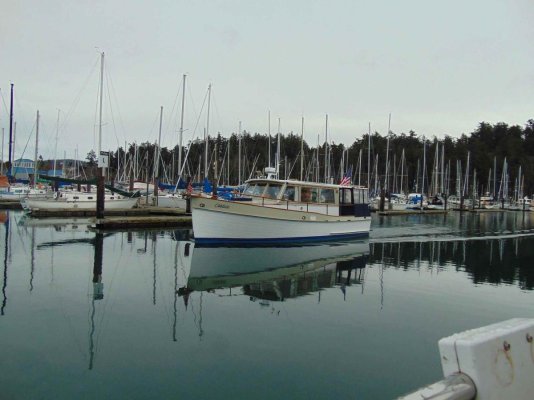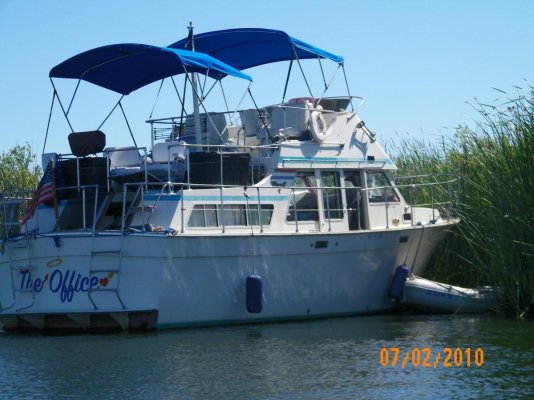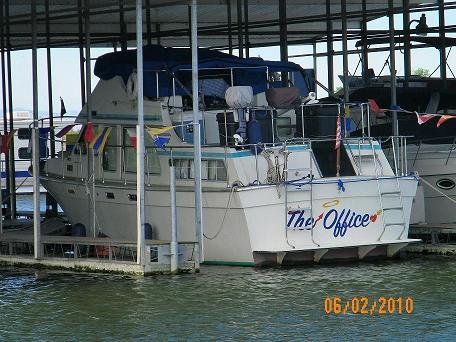You are using an out of date browser. It may not display this or other websites correctly.
You should upgrade or use an alternative browser.
You should upgrade or use an alternative browser.
Holy Windage!
- Thread starter jhance
- Start date
The friendliest place on the web for anyone who enjoys boating.
If you have answers, please help by responding to the unanswered posts.
If you have answers, please help by responding to the unanswered posts.
South of Heaven
Guru
- Joined
- May 11, 2017
- Messages
- 1,167
- Location
- USA
- Vessel Name
- Slow Lane
- Vessel Make
- 2005 Silverton 35 Motoryacht
I feel your pain. I did lots of single handed docking and departing last year on my 1st year with Slow Lane. My windage isn't bad but it's tough being alone when it's windy. However, I actually look at it as a challenge and fun task. I have no problem when other folks on the dock are watching me, I enjoy it! Fun times. If no one wants to come and give me a hand I could care less. I've found that many times other boat owners and guests actually hope that some folks crash and perform badly. Sad but true.....
VicTrawler
Senior Member
- Joined
- Mar 19, 2015
- Messages
- 234
- Location
- Canada
- Vessel Name
- Halcyon I
- Vessel Make
- 1984 36' Universal Europa Sedan
I find myself anticipating the wind and taking an approach that initially looks like I'll be colliding with my dock, only to have the wind nudge me over just enough to enter the slip perfectly. It's tricky and sometime I get it wrong but that's what fenders are for.
Now that I've had the boat for a few years, I've also gone from making "passive" approaches to more aggressive approaches. By doing so you have more response and control. Just know your stopping distance. Also I find the extra revs needed to stop the boat also give me more prop walk which also does a better job of pulling in the stern. A few times I've had people on the dock go from a look of concern to, "oh, you obviously know what you're doing." It comes with experience, I guess.
Now that I've had the boat for a few years, I've also gone from making "passive" approaches to more aggressive approaches. By doing so you have more response and control. Just know your stopping distance. Also I find the extra revs needed to stop the boat also give me more prop walk which also does a better job of pulling in the stern. A few times I've had people on the dock go from a look of concern to, "oh, you obviously know what you're doing." It comes with experience, I guess.
dhays
Guru
- Joined
- May 26, 2015
- Messages
- 9,045
- Location
- United States
- Vessel Name
- Kinship
- Vessel Make
- North Pacific 43
Dave... you leave boat in gear, walking completely away from the controls, while a single dock line is holding the boat's position?? OMG my friend; please be very careful. What could happen, due to several different types of unexpected occurrences, is scary to say the least!
Very good point. If something unfortunate was to happen, it would be messy. However, I in a single slip with fingers on either side. Other than some marks on the fiberglass, a disastrous occurrence wouldn’t cause too many problems.
jhance
Senior Member
I find myself anticipating the wind and taking an approach that initially looks like I'll be colliding with my dock, only to have the wind nudge me over just enough to enter the slip perfectly. It's tricky and sometime I get it wrong but that's what fenders are for.
Now that I've had the boat for a few years, I've also gone from making "passive" approaches to more aggressive approaches. By doing so you have more response and control. Just know your stopping distance. Also I find the extra revs needed to stop the boat also give me more prop walk which also does a better job of pulling in the stern. A few times I've had people on the dock go from a look of concern to, "oh, you obviously know what you're doing." It comes with experience, I guess.
I agree. I think being in gear and being assertive gives you the most control. It seems that when you are at idle and drifting is when the wind/current has it's way with you the most. The only risk, of course, is if you mess up with an aggressive approach you are hitting the dock or other boats at that speed. Many say your speed should be only as fast as you're OK hitting the dock with... and that's fine in most situations. But sometimes you need to be more aggressive.
dhmeissner
Guru
- Joined
- Sep 26, 2012
- Messages
- 1,569
- Location
- North America
- Vessel Name
- The Promise
- Vessel Make
- Roughwater 35
Al
Guru
- Joined
- Apr 1, 2012
- Messages
- 2,206
- Location
- usa
- Vessel Name
- 'SLO'~BELLE
- Vessel Make
- 1978 Marben-27' Flybridge Trawler(extended to 30 feet) Pilothouse Pocket Cruiser[
There's really only one good option to make docking it easier in wind and that is bow thrusters. I know all those who will say they've docked single engine boats for 100 years and never needed them, but there are conditions in which the ability to dock is very poor on a boat like yours.
Otherwise it takes the application of more power than you're probably comfortable in applying in that situation. You have to come in hard and tie quick to overcome the wind. That is contrary to the advice most will give which is designed to prevent damage as it increases the risk of damage if you're too hard or lose power while trying to go for forward to reverse or any number of other things.
A wise observation, I am one of those B/B states regarding bow thrusters, however doesn't the Camano have a bow thruster? There is a sunk recovery Camano in our boat yard and it has one. Other wise a correct statement under your 'Hotel" setup. The second part I am in full agreement with.
Al-Ketchikan
Al
Guru
- Joined
- Apr 1, 2012
- Messages
- 2,206
- Location
- usa
- Vessel Name
- 'SLO'~BELLE
- Vessel Make
- 1978 Marben-27' Flybridge Trawler(extended to 30 feet) Pilothouse Pocket Cruiser[
LMAO!!!!:lol::lol::lol:


 for posting this timely video. Good show!
for posting this timely video. Good show!
Al-Ketchikan
Al
Guru
- Joined
- Apr 1, 2012
- Messages
- 2,206
- Location
- usa
- Vessel Name
- 'SLO'~BELLE
- Vessel Make
- 1978 Marben-27' Flybridge Trawler(extended to 30 feet) Pilothouse Pocket Cruiser[
Dave... you leave boat in gear, walking completely away from the controls, while a single dock line is holding the boat's position?? OMG my friend; please be very careful. What could happen, due to several different types of unexpected occurrences, is scary to say the least!
Art, Art, relax my friend,
 cardiac arrest in play!
cardiac arrest in play!In our case, I utilize the grapple hook from the bridge to the dock bullrails at the mid ship point tying off the grapple hook to a bridge point (Helm chair) remaining in gear as required till I secure a proper stern line. There is no stringent amount of power, just the dead idle setting.
Now with twins such as you have, and maybe a thruster, this whole procedure takes a different hue.

Al-Ketchikan
tpbrady
Guru
I put a bow stem on last spring just so I could single hand in a wind or tide. Ease the bow all the way to the front of the slip until the bow engages the dock, put it in gear with the wheel to port and the starboard quarter should be right against the dock and will stay there until taken out of gear.
Tom
Tom
Art, Art, relax my friend,cardiac arrest in play!
Quite the normal set up and one I would have were there a midship cleat available, however, too short a boat for the application in my case, on larger boats it is quite common to have folks utilize a midship spring line and then hold in gear to set the remaining lines. Most commercial boats have a permanent midship line expressly for the need.
In our case, I utilize the grapple hook from the bridge to the dock bullrails at the mid ship point tying off the grapple hook to a bridge point (Helm chair) remaining in gear as required till I secure a proper stern line. There is no stringent amount of power, just the dead idle setting.
Now with twins such as you have, and maybe a thruster, this whole procedure takes a different hue.
Al-Ketchikan
Al - Baby! No feigned heart attacks here. There are two spring line cleats on each side of our little baby!! one in front and one to rear of slider.

Attachments
Heron
Guru
- Joined
- Nov 5, 2014
- Messages
- 1,304
- Location
- USA
- Vessel Name
- Heron (2)
- Vessel Make
- '88 Cape Dory 28 Flybridge #115
Not seeing how you get a line over a cleat from the helm single handed while the wind is pushing you away from the dock?
Coming in to dock against the wind is probably the most difficult docking/undocking situation there is.
Solved that problem (for my wife) with a product called the docking stick. Inexpensive for a pair on Amazon. Her lassoing skills are now flawless (and less stressful...)
https://www.amazon.com/Docking-Stick-Boat-Adapters-package/dp/B00BK6LE4Y/ref=sr_1_1?ie=UTF8&qid=1520273625&sr=8-1&keywords=docking+stick&dpID=51Xjae9eXeL&preST=_SX300_QL70_&dpSrc=srch
dhays
Guru
- Joined
- May 26, 2015
- Messages
- 9,045
- Location
- United States
- Vessel Name
- Kinship
- Vessel Make
- North Pacific 43
Solved that problem (for my wife) with a product called the docking stick. Inexpensive for a pair on Amazon. Her lassoing skills are now flawless (and less stressful...)
https://www.amazon.com/Docking-Stic...pID=51Xjae9eXeL&preST=_SX300_QL70_&dpSrc=srch
That is a unique idea. I like it.
BruceK
Moderator Emeritus
- Joined
- Oct 31, 2011
- Messages
- 13,347
- Vessel Name
- Sojourn
- Vessel Make
- Integrity 386
Here is the Aussie product at: WRINO boat hook mooring system for easy boat docking from onboard
Been around a while, available locally at Whitworths.
Been around a while, available locally at Whitworths.
South of Heaven
Guru
- Joined
- May 11, 2017
- Messages
- 1,167
- Location
- USA
- Vessel Name
- Slow Lane
- Vessel Make
- 2005 Silverton 35 Motoryacht
Here is the Aussie product at: WRINO boat hook mooring system for easy boat docking from onboard
Been around a while, available locally at Whitworths.
That looks slick!! I may have to add that to my spring list.
Here is the Aussie product at: WRINO boat hook mooring system for easy boat docking from onboard
Been around a while, available locally at Whitworths.
You may find that this product works better in the pictures than it does in real life. Remember, you don't have that extra person on board to use it. You'll have to fool with this and drive the boat. And it's not going to help unless you cleat the bitter end of the line to your boat first.
In Savannah, GA there's a passenger ferry that goes back and forth across the river. The guy tosses a heavy line over a cleat and the powers the boat to the dock. Of course, he does this every twenty minutes, eight hours a day so he's gotten pretty good at it.
Pretty lucky with our flying bridge controlled, easy to handle, twin screw, 12'6" beam boat... and... the gated, covered, 16' wide, dual finger-dock slip we berth in. Due to loading and other placement reasons it is to our advantage to dock bow-in and back out when leaving. Also, there is a fairly wide expanse of water to get out into [100' +/-] with the center of a full, uncluttered channel just a couple hundred feet away.
Metal posts that help support the roof are positioned perfectly for both spring line cleats on either side of our boat's gunnel. We have two short lines that wrap around each post and hook right onto the cleats - easy peazie for initial hook up with two aboard! Additional to those short springs we eventually fasten two lines off bow and two off stern to dock cleats before leaving... in wait for another weekend aboard. That's six lines fastened to dock and there are a few boats to wind side of us for wind break!
To dock her in our berth with just me aboard: The metal posts go right up past the edge of fly bridge. Super easy to bring boat to full stop next to posts, grab post with boat hook, pull boat hard against finger dock, and... tie temp line off bridge that I have ready. Then I scurry down to hook on the two short springs around the posts and hooked to gunnel spring line cleats. Another Easy Peazie docking experience.
Metal posts that help support the roof are positioned perfectly for both spring line cleats on either side of our boat's gunnel. We have two short lines that wrap around each post and hook right onto the cleats - easy peazie for initial hook up with two aboard! Additional to those short springs we eventually fasten two lines off bow and two off stern to dock cleats before leaving... in wait for another weekend aboard. That's six lines fastened to dock and there are a few boats to wind side of us for wind break!
To dock her in our berth with just me aboard: The metal posts go right up past the edge of fly bridge. Super easy to bring boat to full stop next to posts, grab post with boat hook, pull boat hard against finger dock, and... tie temp line off bridge that I have ready. Then I scurry down to hook on the two short springs around the posts and hooked to gunnel spring line cleats. Another Easy Peazie docking experience.
Attachments
Pretty lucky with our flying bridge controlled, easy to handle, twin screw, 12'6" beam boat... and... the gated, covered, 16' wide, dual finger-dock slip we berth in. Due to loading and other placement reasons it is to our advantage to dock bow-in and back out when leaving. Also, there is a fairly wide expanse of water to get out into [100' +/-] with the center of a full, uncluttered channel just a couple hundred feet away.
Metal posts that help support the roof are positioned perfectly for both spring line cleats on either side of our boat's gunnel. We have two short lines that wrap around each post and hook right onto the cleats - easy peazie for initial hook up with two aboard! Additional to those short springs we eventually fasten two lines off bow and two off stern to dock cleats before leaving... in wait for another weekend aboard. That's six lines fastened to dock and there are a few boats to wind side of us for wind break!
To dock her in our berth with just me aboard: The metal posts go right up past the edge of fly bridge. Super easy to bring boat to full stop next to posts, grab post with boat hook, pull boat hard against finger dock, and... tie temp line off bridge that I have ready. Then I scurry down to hook on the two short springs around the posts and hooked to gunnel spring line cleats. Another Easy Peazie docking experience.
Looking good Art!
Improve your docking experience by attaching your stern spring permanently to one of those posts, near or at the stern of your boat. Then, as you enter your shelter, grab the loop of that spring line from its convenient hook at chest level and drop it over the fwd spring cleat. Go to the other side of your boat, do the same with a similarly positioned line on the other side, then as the boat reaches the end of slack in those springs, it stops, exactly where you want it, away from any possible contact with the front of the shelter. Then you can grab the twin bow lines that are again attached to the support posts near the bow and that you can now drop onto the bow cleats. All that is left to do is grab the power cord, which is conveniently hanging near the on board connector, hook it up and engage shore power.
I would add a little carpet on the posts where your gunwhale could make contact as you enter the shelter and at contact points once settled inside. Then no fenders are required.
Similar threads
- Replies
- 0
- Views
- 371
- Replies
- 6
- Views
- 946



